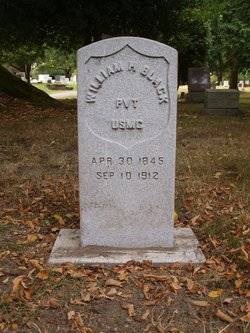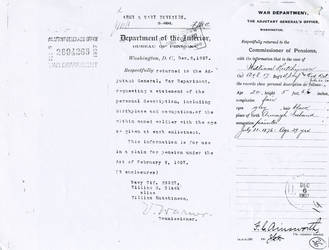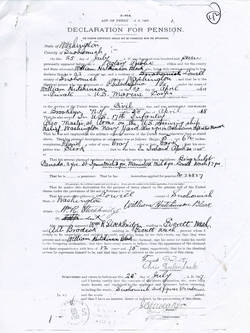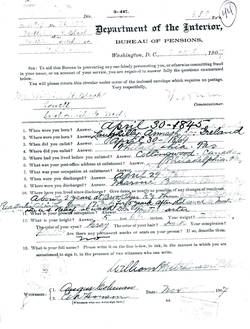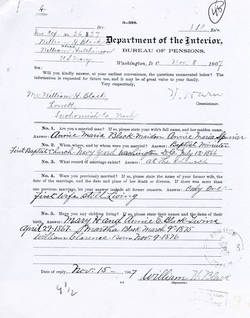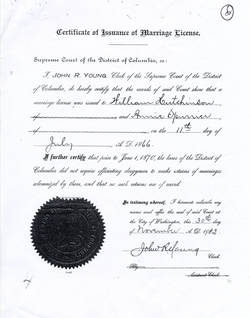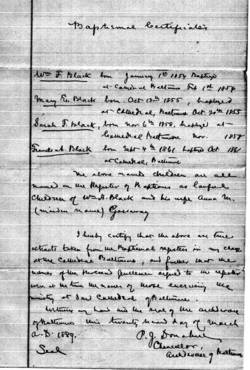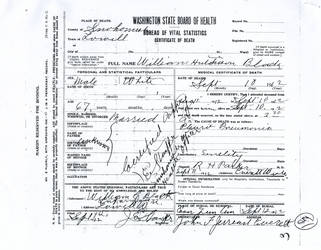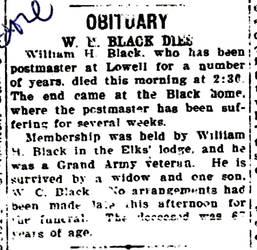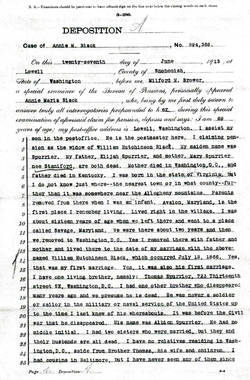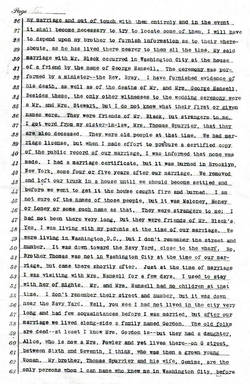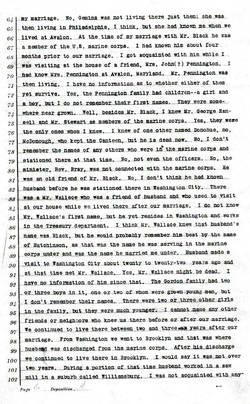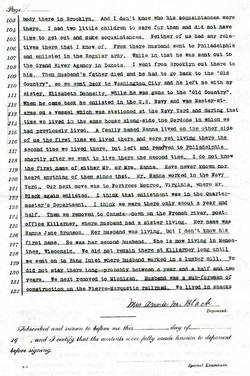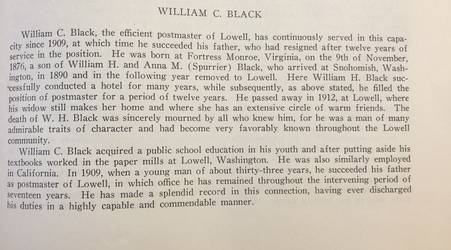William Hutchinson Black
Representing: Union
G.A.R Post
- John Buford Post #89 Everett, Snohomish Co. WA
Unit History
- United States Marine Corp.
Full Unit History
U.S. MARINE CORPS
Organized: 11/10/1775 Philadelphia, PA
Regimental History
U.S. MARINE CORPS HISTORY:
The United States Marines, initially called the Continental Marines, were founded on November 10, 1775 in Philadelphia, PA. Their original mandate was to fight for freedom on sea and on shore. This they did between the date of their founding and the beginning of the American Civil War, most notably in 1805 at the Battle of Derna on the shores of Tripoli and in 1847 during the Mexican-American War during the battle of Chapultepec when, after two days of fighting, they gained control of a castle known as "The Hall of Montezuma." Prior to the onset of the Civil War it was a contingent U.S. Marines that, in 1859, captured John Brown and his men at Harper's Ferry, VA.
In December, 1860 muster rolls of the U.S. Marines showed 63 officers and 1,799 enlisted men. With the outbreak of the war, some of the Union Marine officers deserted to join the Confederate Marine Corps. Four years later, near the end of The Rebellion, the rolls carried 91 officers and 3,791 enlisted men.
Unlike their U.S. Army cousins in the infantry, artillery or cavalry, during the Civil War Marines were not assigned to companies or regiments. They were just "Marines" who, for the most part, were assigned to serve on board individual vessels or on land. The same was true for their U.S. Navy brethren.
Aboard ship the Marines role was to protect and defend their vessel by manning artillery pieces and serving as sharpshooters. Shipboard Marines also served as amphibious assault forces attacking land target such as during the Battle of Mobile Bay, AL.
On land, the Union Marines were stationed at barracks located in or near U.S. Naval shipyards located in Philadelphia, PA, Boston, MA, Brooklyn, NY, Washington, D.C. and Portsmouth, NH. They also participated as infantry in many battles included First Bull Run, VA and Honey Hill, SC. On one occasion, May 15, 1862 at Drewry's Bluff near Richmond, VA, Union Marines came into direct battle contact with Confederate Marines.
During the American Civil War enlistment periods for men entering the U.S. Army varied widely with most terminating at war's end regardless of time left to serve. This was not the case for Marines. The enlistment period was four years. As such, after the War's end, those Marines who's enlistments had not yet expired continued to serve out their enlistment period.
U.S. Marine losses during the American Civil War were as follows: 102 died as a result of enemy action; 233 died from accidents or disease; 175 wounded in action; and 276 taken prisoner.
Soldier History
SOLDIER:
Residence: Philadelphia, PA Age: 18.0 yrs.
Enlisted/Enrolled: 4/30/64 Philadelphia, PA Rank: Pvt.
Discharged: 1868 Brooklyn Navy York, Brooklyn, NY
Highest Rank: Pvt.
Family History
PERSONAL/FAMILY HISTORY:
William Hutchinson Black was born in Laughilly, Armagh County, Ireland. His birth date was April 30, 1845. As far as we know, he had no brothers, but at least three sisters, the names of two, Hanna and Jane, are documented. The names of his parents are not known.
The Blacks appear to have emigrated from Ireland when William was a child, apparently settling in Canada. Family documents were reportedly destroyed there in 1857 by fire. William's parents or at least his father, apparently then moved to the United States and settled in New York State for a time before returning to Ireland. William reportedly came to the U.S. from Collingwood, Ontario, Canada in 1862/'63.
On 4/30/64, on his eighteenth birthday, William volunteered to serve in the U.S. Marine Corps for a period of four years. Interestingly enough, he enlisted not as William Black, but as William Hutchinson. Why the name deception is not known. At enlistment William was described as 5'7 1/4" tall, having black hair, brown eyes and a florid complexion. His employment at the time was listed as "clerk."
Almost immediately after his enlistment Private Hutchinson was transferred to the Marine barracks at Washington, D.C. where he was soon hospitalized for diarrhea. In June he was transferred again, this time to the Washington (D.C.) Naval yard where he was hospitalized on two occasions, once for Syphilis Primitive Chancre and thereafter for a condition identified as disatomopid.
On 3/21/65 Private Hutchinson was again admitted to the hospital, this time for a period of three days. Admittance injury was contusion of the left side of his genitalia caused by running against a tree while (horsing around) with another marine. Medical documents noted that the injury was not received while in the line of duty! The only other medical notation was in July when William was hospitalized for another four or five days with diarrhea.
During the American Civil War most service enlistments were for a specific period, say three years, or the duration of the war. When the war was over, so was the period of service unless a person re-enlisted. Such was not the case for the U.S. Marines. A four year enlistment was just that, a four year enlistment. As such, although the Rebellion ended in 1865, William was bound to an enlistment which would end in April, 1868.
On 7/12/66 while still in the Marines William married Annie Maria Spurrier (b. 12/44 VA), a woman he had known for about four months, at the Baptist Church located in the Washington Naval Yard. She was the daughter of Elijah and Mary Staniford. The union would produce eight children, only four of whom apparently survived infancy and grew to adulthood; Annie E and Mary H. (b. 4/29/67 Wash., D.C. /MD), Martha (b. 3/9/75 Wash., D.C./MD) and William Clarence (b.11/9/76 Monroe Co. VA).
After their marriage, William and Annie settled in Washington, D.C. where they remained for two or three years even though William was away from home much of the time. On 12/11/66 he was transferred to the Brooklyn Naval Yard in New York and a few weeks thereafter was assigned aboard the U.S.S. Peoria, a double ended steam side-wheeler. On 8/19/67 William was re-assigned once again, this time to the barracks at the Portsmouth, NH Naval Yard. From there, on 10/19 he returned to Brooklyn where he was discharged on 4/30/68.
Upon exiting the Marine Corps William and family apparently settled in Brooklyn, NY at which time he found employment in a sawmill located in the suburb of Williamsburg. Although the Blacks cannot be located in the 1870 census, they apparently remained in Brooklyn until mid '70 when they removed to Ft. Sully in Dakota Territory.
How the family came to move from New York to the Dakotas’ is as follows: On 7/24/70 William, then 24.2 years of age, re- entered the U.S. military, this time as a private in the U.S. Army's 17th Infantry, within which he was assigned to Company "A". Once again, the enlistment was as William Hutchinson, not William H. Black.
After enlisting in Philadelphia, PA Private Hutchinson was transferred to the Grand River (Indian) Agency located in Dakota Territory. His wife and young children made the move with him.
Private Hutchinson's five years of service with the 17th proved to be fairly benign. On 11/3/71 he transferred from company "A" to company "E.” Other than the transfer his only other military record notations pertain to various short-termed illnesses/injuries such as treatment for deafness, varicose veins, varicocele, a toe injury, a sprain, a contusion on his right hand and catarrh (likely a sinus infection.).
It appears William's period of service with the 17th would have run until mid-1875, but on January 15th of that year, based upon "a special favor of his own request", he was discharged at Washington, D.C. Likely the request and early discharge was based upon the death of William's father in Ireland, which necessitated his returning to the "old country" to settle family affairs. This was done during the first months of ’75. During his absence Annie and the children moved to Washington, D.C. to live with her sister.
Although it is not known if William made it back to the U.S. for the birth of his third child on 3/9/75, he was definitely back in the States by 3/29 because it was on that date, in Washington, D.C., he entered the U.S. military for a third time. On this occasion he enlisted as a landsman (new sailor) in the U.S. Navy. During his navy enlistment he would serve aboard the receiving ship (induction center) U.S.S. Relief as a corporal until being transferred to the Washington Naval Yard as Master at Arms when that vessel was decommissioned. As far as can be determined, his enlistment was once again as William Hutchinson. While in the Navy the Blacks lived in the same Washington D.C. house in which they had resided during the Civil War.
William's Navy stint was a short one as he was discharged on 3/28/76. Almost immediately thereafter at Ft. Monroe, VA he rejoined the U.S. Army as a second private of ordinance for a period of five years. At the time of this fourth military go-round he noted his occupation as "painter." For whatever reason, William's army service did not last a full five years. On 6/20/78 he was discharged from the military for the final time.
William and family next moved to a place called Killarney along the French River in Canada where his sister Hanna resided. It appears that at some point during this period of his life he was employed as a (mill) watchman in summer and as a "scaler" in winter.
Circa 1879/'80 the Blacks moved to Bing Inlet, Ontario Canada where William worked for one and a half / two years in a lumber mill. The Canadian exposure did not last long, however, as by 1881/'82 the Blacks were back in the U.S. living in Michigan in shacks along the new route of the Pierre-Marquette Railroad with whom William was employed as a sub-foreman of construction. Apparently his position involved cutting wood for the railroad. This existence lasted seven months, perhaps longer.
Sometime during 1882 the Blacks moved to Palm Station, MI where William continued employment for perhaps a little more than a year cutting wood. This settling was followed in 1883 by a move to Newberry, MI where the wood cutting continued about another year.
It was during this Newberry period that William would later claim in documents filed to claim a U.S. Government disability pension based on his Civil War-era Marine Corps service, that he was severely hampered from performing manual labor (cutting wood) because of rheumatism which he had contracted from exposure while on duty at the Brooklyn Naval year in January and February, 1868. Also, he claimed that during the year 1864 he had incurred varicose veins in both legs and (his) testicles by doing duty which required him to stand on his feet for long periods of time. On one occasion while in Newberry he was incapacitated for two months by one or both of these conditions. He also claimed that he continued to lose work time in 1884 after he had moved to Manistique, MI where he was employed as a painting foreman/overseer. It is not known if a pension stipend was subsequently granted.
While no census data is available on the Blacks for 1890, likely it was sometime during that year they moved from Michigan to the Puget Sound area of Western Washington State. Exactly why they moved west to settle in the farming community of Lowell near the Snohomish County City of Everett is not known, but more than likely it was because of adult children living in the area. Of note for the Blacks was that with their move to Lowell they purchased a house and five acres of land. This was the first time in William and Annie's marital history they had actually owned property.
The census for 1900 placed the Blacks in Lowell where William was the local postmaster serving in that position for twelve years when in 1909 he retired and his son William Clarence became Postmaster. Besides his wife, also in the home was daughter Annie.
A decade later the 1910 census found the Blacks still in Lowell. At that time William was noted as a painter. Within that year’s U.S. Census Annie noted that she had borne eight children, four of whom were still living. Of those four, two, Annie and Clarence, now a postmaster of Lowell, resided in she and William’s household.
It appears William Hutchinson Black took ill in August of 1912. He was treated by a doctor for almost a month before succumbing to pleurisy pneumonia on September 10th. Burial was in Everett's Evergreen Cemetery.
In June, 1913 William's widow, Annie began the process of attempting to obtain a government pension based on her late husband's military service. In this effort she was aided by Everett attorney Robert Warner, also a civil War vet who is buried in the G.A.R. Cemetery in nearby Snohomish, Snohomish County, WA. An initial roadblock encountered by Warner was a government pension office claim that although William and Annie had obtained a marriage license in 1866, there was no record of a wedding ceremony ever being performed. Outcome of the contestation is not known.
In 1920 Annie Black was still residing in Lowell. At that time head of the household was her son William Clarence now employed as clothing merchant. Also in the home was Annie's daughter and William C.'s sister, Anna.
By 1930 Annie was living with her daughter Annie E Wagner and son William C. Black she was 85 years old. Annie Spurrier/Black died 1/24/1931 in Everett, WA and is buried beside her husband William at Evergreen Cemetery.
Cemetery
Buried at Evergreen Cemetery Everett
Row: 26
Site: 287
Adopt-a-Vet Sponsor
Robert Emberger
Somerville, NJ
